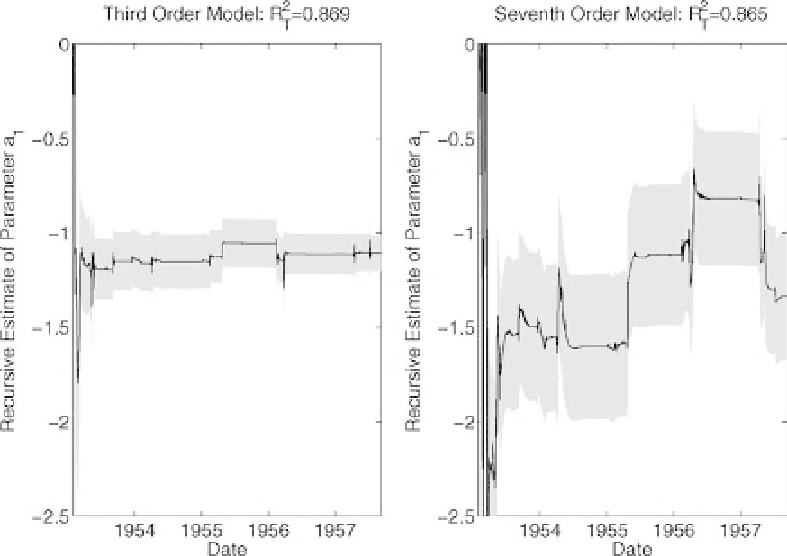Environmental Engineering Reference
In-Depth Information
Fig. 9.5
Comparison of recursive estimates of the parameter a
1
obtained for an identifiable third-order model
(left panel) and a poorly identifiable seventh-order model (right panel).
virtually the same extent as the well-identified
model: theNash-Sutcliffe efficency (equivalent to
the coefficient of determination based on the sim-
ulated model response) is R
T
¼ 0:864
compared
with R
T
¼ 0:869
for the third-order model. More-
over, the recursively updated seventh-order model
quite often explains the data well at intermediate
samples over the dataset, as we see in Figure 9.6.
Here, the simulated response of the model ob-
tained in the third month of 1955 (R
T
¼ 0:869
)is
compared with the responses of the seventh- and
third-order models estimated at the end of the
data, in the eighth month of 1957. All the models
explain the data reasonably well but the two
seventh-order models have substantially different
estimated parameters.
When considering the recursive estimation re-
sults for the seventh-order model in Figure 9.4, it
might be thought that the significant changes in
the parameter estimates are redolent of nonstatio-
narity in the model, with the parameters needing
to change to reflect changing effective rainfall-
flow dynamics. But this is clearly not the case,
since the third-order model has an equivalent
ability to explain the observed flow variation and
its parameter estimates change very little. In other
words, the estimation results in this over-param-
eterized situation are highly misleading. The im-
portance of this phenomenon in terms of real-time
updating is clear: while the recursively estimated
parameters of the identifiable third-order model
converge to reasonably well-defined values that
change only a little over the whole of the data, the
parameters of the over-parameterized, seventh-
order model are highly volatile and never converge
to stable values.
The fact that, for most of the observation inter-
val, the estimated model explains the flow data as
well as the third-order model, despite this volatil-
ity, shows that the estimates are inherently am-
biguous and the model is poorly identifiable: a
condition that has been termed 'equifinality' by
von Bertalanffy (1968) and used in the hydrological
literature by Beven and Freer (2001) and Beven
(2006). Moreover, one of the eigenvalues of the
seventh-ordermodel is very close to the instability

